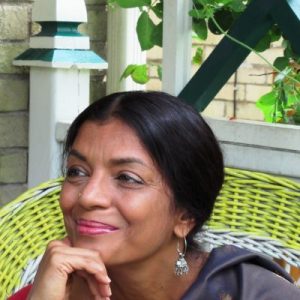7 How I Learned to Think Critically: A Reflection on Culture and Writing Identity
Srividya Natarajan
In my childhood home in India, almost every room contained shelves that were bursting with books in three languages. Curled up next to those shelves, or visiting the tiny local library, I devoured everything I could get hold of: novels, poetry, plays, philosophy, art history, even the dusty anatomy and physiology textbooks my doctor parents had used in medical college. My mother tongue (L1) is Tamil, a south Indian language. English is my L2—my second language—but I grew up reading more in English than in Tamil. It did not surprise anyone that I chose to study English literature in high school and, later, at university.
Since moving to Canada seventeen years ago, I have been teaching here. Since I come from a different culture, I see Western academic norms from the point of view of an “outsider.” I believe multilingual writers have writing skills that are in no way inferior to those of their Canadian classmates; what they need to learn through reading and practice, however, are ways of adapting to the writing culture in Canada. I agree with Zhang that teachers have a responsibility “to help … students learn the expectations of the new academic settings and [to] raise their awareness of writing differences across cultures” (21). An important expectation in Canadian universities is that students think critically. International students must build a bridge between their home country’s academic training and this requirement in their new setting. Reflecting on how I myself built this bridge, I have come to the conclusion that critical thinking can be taught by tapping into the strengths of an “Eastern” or “Asian” educational approach.
My education in India was very “Eastern” in approach. My teachers generally wanted me to memorize facts or texts and to imitate models. My culture was what Shen would call a “collectivist” culture: family and community were highly valued, and, unlike in the West, individualism and strong opinions were not welcome. Despite this, two things pushed me towards what the West calls critical thinking. First, as a good student, I began to memorize and imitate Western models of literary criticism for my high school English Literature exams. Second, I was a rebel by nature, always questioning everything, including my culture’s beliefs. I often got in serious trouble for challenging my teachers. So if basic critical thinking is defined as the ability a) to be curious; b) to identify and analyze problems; c) to understand where people’s ideas and actions come from (e.g., family, social value systems, religion, and so on); and d) to evaluate ideas, giving clear reasons for one’s point of view, I learned how to do it partly because of my temperament, and partly by reading, memorizing, and imitating models.
With practice, I got good at critical thinking, especially when I found the subject interesting. When a subject did not engage me, however, critical analysis did seem tiresome. In other words, the choice of subject plays an important role in stimulating critical thought.
Works Cited
Shen, Fan. “The Classroom and the Wider Culture: Identity as a Key to Learning English Composition.” College Composition and Communication, vol. 40, no. 4, 1989, pp. 459-66, https://doi.org/10.2307/358245.
Zhang, Yufeng. “The Impact of ESL Writers’ Prior Writing Experience on their Writing in College.” Additional Essays, Companion Site for What is “College-Level” Writing. Vol. 2, National Council of Teachers of English, 2010, cdn.ncte.org/nctefiles/resources/books/collegelevel2/yufengzhang_final.pdf?_ga=2.228630740.974481951.1683917960-2141036358.1683917949&_gl=1*18we6es*_ga*MjE0MTAzNjM1OC4xNjgzOTE3OTQ5*_ga_L5Q68NRK05*MTY4MzkxNzk0OS4xLjEuMTY4MzkxNzk5Ny4xMi4wLjA.
About the author
Srividya Natarajan
King’s University College

Dr. Srividya (Vidya) Natarajan (she/her) teaches Writing and coordinates the Writing Program at King’s University College, London, Canada. Her research focuses on Writing and Writing Center pedagogy in relation to racial, gender, caste, and disability justice. She has co-edited a special section of Discourse and Writing/Rédactologie and a special issue of The Peer Review on changing writing centre commonplaces in response to anti-oppressive frameworks. In her parallel life as a novelist and creative writer, she has authored The Undoing Dance, No Onions nor Garlic, and co-authored A Gardener in the Wasteland, and Bhimayana.

